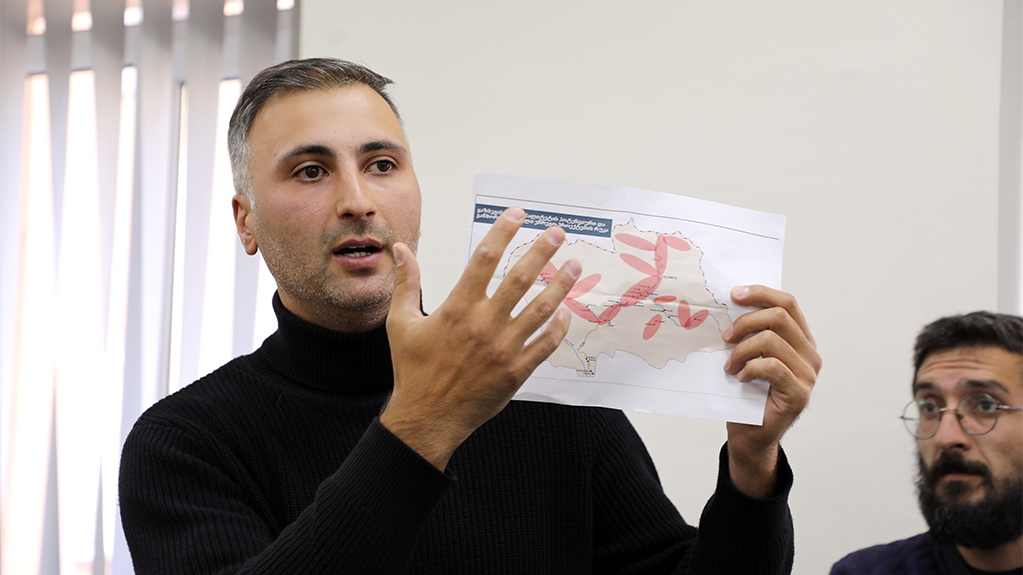After Kazbegi residents disrupted the public discussions on the matter, the National Environmental Agency stopped the administrative proceedings in connection with the construction of the new Kamara hydroelectric plant on the Tergi River.
News
- On September 18, a public review of the scoping report was held, where the residents raised objections mainly on the channeling of the Tergi River into a pressure pipeline, impact on tourism, expected geological hazards, and visual impact on the landscape.
- On September 19, two additional public discussions were planned, however, due to public disapproval and protest, sessions planned in Sioni Village and Kazbegi were called off.
- The updated scoping report should reflect facts of informing the population, considering their point of view, and gaining agreement.
- In addition, the presented documentation speaks to only the positive effects expected from the project and does not touch on the possible negative impact of the construction/exploitation.
- As an alternative to the location of the HPP, the option is considered, which, if implemented, has a high probability of significantly affecting the biodiversity, unique complexes, and natural landscape. This option cannot be considered a reasonable alternative.
- Information about the expected impact of the planned transfer of the 110 kV power line is not presented.
- Taking into account the reduced water current at the operational stage of Kamara Dam, the information on the potential of solid matter transportation by Tergi River needs to be clarified, with appropriate justification. Additionally, the possibility of periodically releasing the full current of water into the Tergi Rivel channel needs to be discussed.
- The visual impact on the landscape in the project area, caused by the arrangement of the HPP infrastructure and power transmission lines, needs clarification.
- Information on the risks of damage to the pressure pipe and the expected dangers (especially near villages of Kanobi, Khurti, Goristsikhe, and their vicinity) and the alternative of placing the pipeline elsewhere should be presented.
- Information on the expected impact (considering the risks of swamping) on the areas near the main structure of the HPP should be presented.
- According to the National Agency for Cultural Heritage Preservation, a part of the project area, specifically, a part of the pipeline and the N2 landfill falls within the visual protection areas of the cultural heritage - immovable monuments ‘Phkhelshe Castle and Church’ and ‘Goristsikhe Avsajanaant Castle.’ In the visual protection area of a monument, it is forbidden to carry out actions that will damage the historically formed environment of the monument, obstruct an optimal view or holistic perception of the monument, or diminish its value.
- Due to the high probability of the presence of archaeological objects in one section of the project area, it is necessary to carry out an archaeological survey provided for in the second stage before the start of earthworks, and in the rest of the project area, earthworks should be conducted under the periodic supervision of an archaeologist.
- According to the information from the National Agency for Mineral Resources, the project area crosses the contours of the land licensed for the purpose of extracting minerals (sand-gravel)
- The scoping report includes technical flaws, among them, the diagrams are of low resolution and the inscriptions are presented in different languages; the names of the rivers need to be clarified, and the textual part of the document is presented with terminological inaccuracies and sentences with content inconsistent with the planned activity, for example: "Ichthyofauna of the rivers Paravani and Korkhi;'' "Impact on water-loving animals of the river due to the changes in the hydrological conditions of Paravani and Korkhi", - reads the report of the National Environmental Agency.
Mountain Stories wrote that discussions on the Kamara HPP construction project resumed in September after a two-year break. According to the project, the Tergi River in Kazbegi will be diverted into iron pipes for another 5 kilometers, from Kanobi to Goristsikhe. The local population is against the construction of another HPP in the district. The main reason is that because of the already-built hydroelectric power plants, the valleys of Tergi and Khdi are dried up during summer. For the smooth operation of HPPs, water is fully diverted to pressure pipelines. According to Mokhevians, the valleys left without water no longer attract tourists, and tourism is the main source of income in this region. A total of 10 new dams are planned to be built in the Kazbegi municipality - no valley will be left in the region where the water flows freely.















